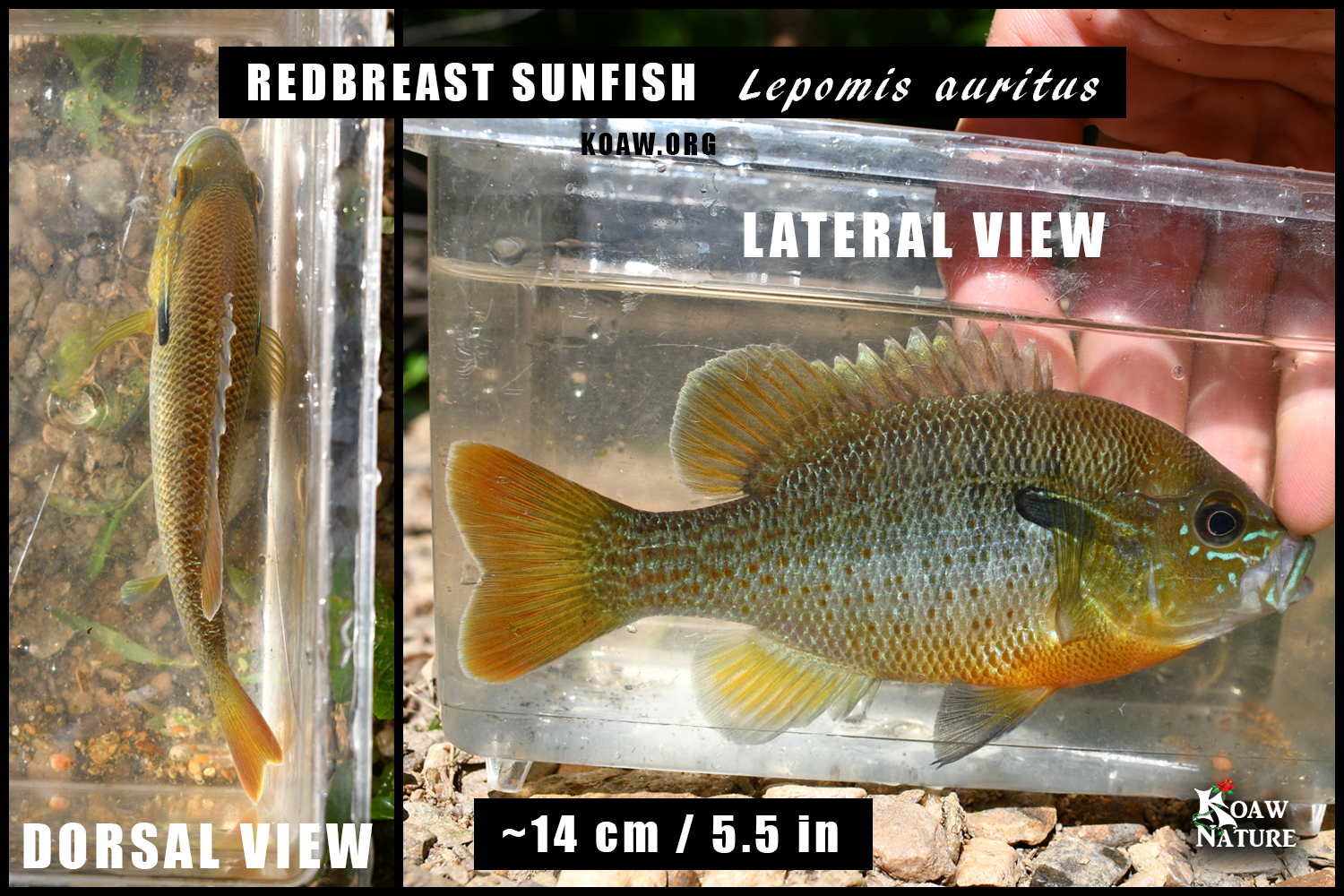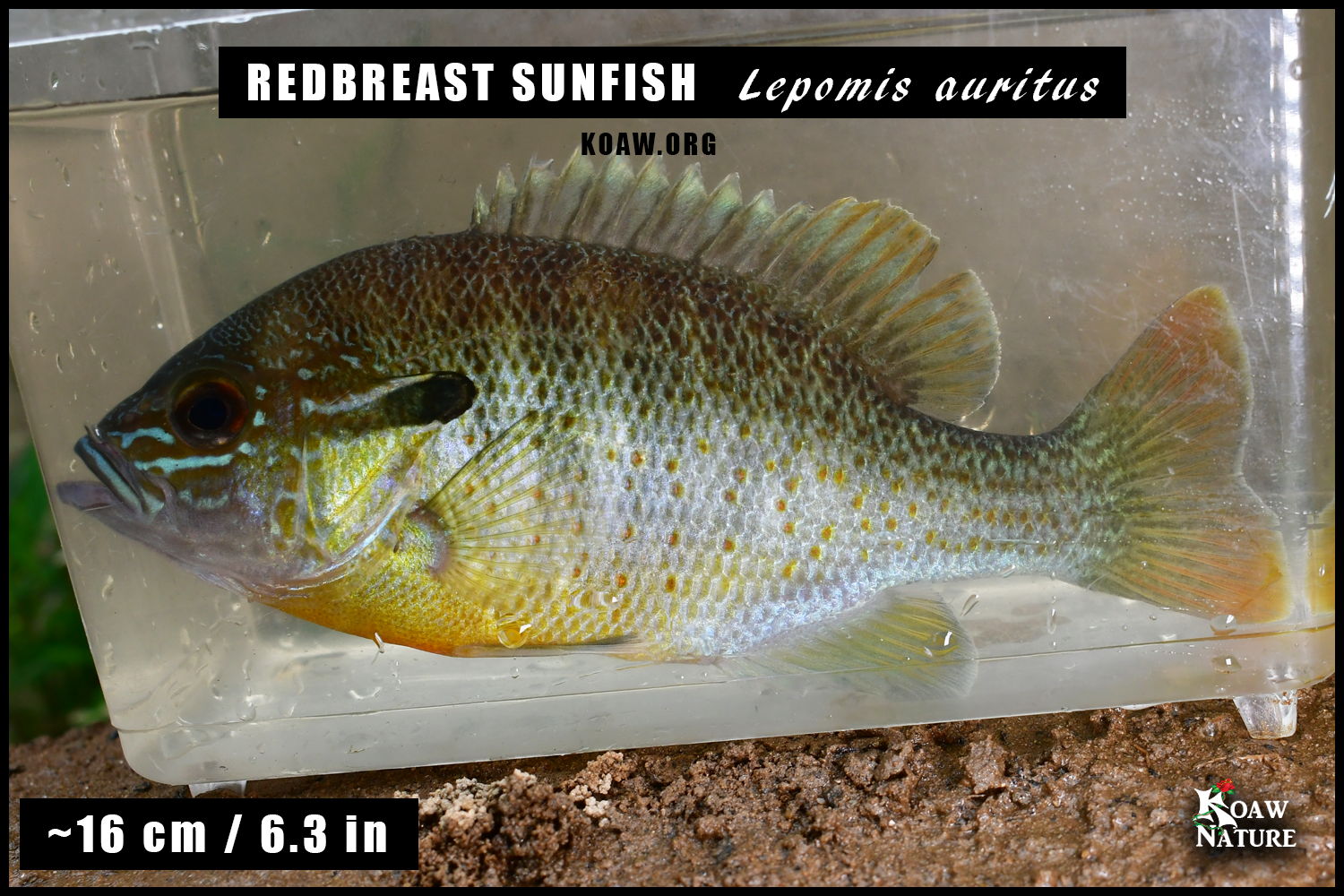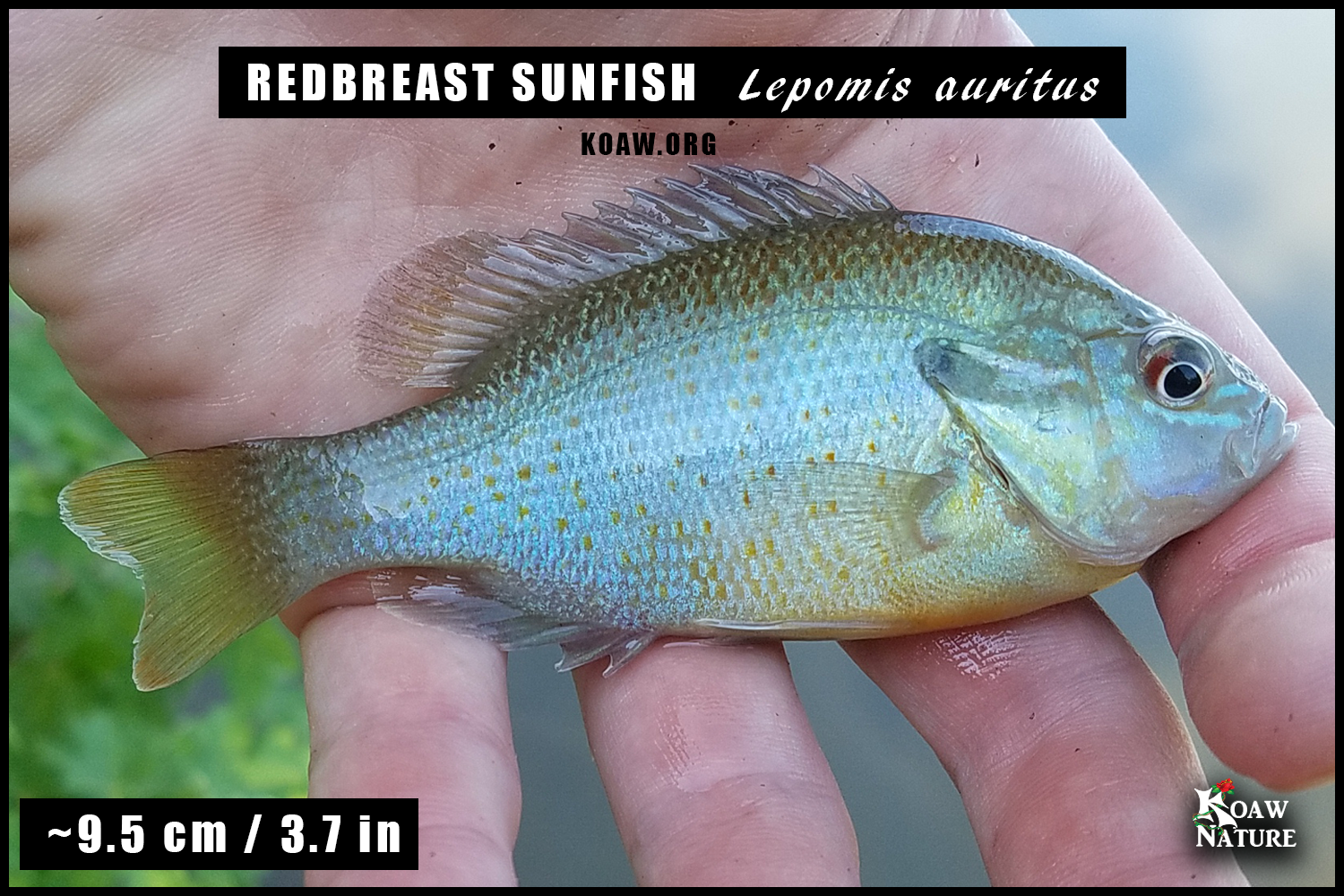By Koaw - November, 2020 (Updated April, 2021)
GENERAL: The redbreast sunfish (Lepomis auritus – Linnaeus, 1758) is very successful in rivers and creeks. Great features to examine for identification are the long ear flap with light blue/white edging on the top and bottom with a black back edge as well as the red/orange breast. The fairly large mouth, blue streak across the upper lip and moderately elongated body shape are also good features to examine.
The redbreast sunfish hybridizes in nature with other lepomids including, but not limited to, the green sunfish (L. cyanellus), bluegill (L. macrochirus), pumpkinseed (L. gibbosus) and warmouth (L. gulosus). [1]
Typically there are 10 dorsal spines, 11 dorsal soft rays, 9 (10) anal soft rays and 14 pectoral rays.[2][3]
OTHER COMMON NAMES FOR REDBREAST SUNFISH (Lepomis auritus) : yellowbellied sunfish, yellowbelly sunfish, sun perch, redbreast bream, robin, & longear sunfish (not to be confused with Lepomis megalotis, hence why the common name “longear sunfish” now strictly refers to the L. megalotis species complex).
BODY: Like all species within the genus Lepomis the redbreast sunfish has a deep body that is strongly compressed. The body of a redbreast is better described as “moderately deep” [4] as the profile is often more elongated relative to a bluegill (Lepomis macrochirus). The lateral line is complete with 39-54 lateral scales. [2]
COLORATION: Redbreast sunfish will change colors and patterns with age as well as during breeding seasons. A typical adult specimen will be dark olive in color dorsally fading to a greenish blue along the sides and into a reddish orange to yellow along the belly. [4]
The lateral sides of the upper body will often have brown to brick-red to dark orange spots while the lower body has lighter orange spots. The mouth, cheek and operculum will often have bright wavy blue lines running laterally. A blue streak is often present running along the upper lip; (see adjacent photo.) The fins can vary in color from dusky to clear but often have some red or orange within the median fins. Breeding males will have very pronounced red/orange colors on the breast and belly as well as darker fins.
Young smaller than 1.0 - 1.5 inches will have two dark lines along the top of the gill plate leading to the opercular flap [2] but none of the bright coloring of an adult; a slimmer profile with a larger mouth helps distinguish young redbreast from young pumpkinseed and bluegill. [4] It is very hard to ID juvenile lepomids smaller than 1.0 - 1.5 inches.
SIZE: To 24 cm (9.5 in) [2] ; IGFA All-Tackle Record: 0.79 kg (1 lb 12 oz) [5]
OPERCULAR FLAP: The dark “ear flap” at the posterior of the operculum is very long and narrow, usually no wider than the eye. The posterior edge of the opercular flap will be black on the posterior edge with a shiny blue/white edging dorsally and ventrally.
The elongation of the ear flap does not occur on young and extends with age.
GILL RAKERS: The gill rakers on the 1st gill arch will be somewhat long and somewhat thick; (*it varies somewhere between 2 to 10 times as long as thick.) [6] For comparison, the rakers of a redbreast may in some instances appear as long as a bluegill’s rakers but the redbreast will not have rakers as thin.
These rakers on the 1st gill arch are found by gently lifting the gill plate of the fish and examining the white portion above the red gill filaments; the 1st gill arch will be closest to the gill plate.
I made a video describing how to locate and find these rakers that is hosted on Koaw Nature’s Fishing Smarts YouTube channel.
MOUTH SIZE: The mouth is fairly large with the upper jaw extending to or under the eye’s pupil.
More specifically, the maxilla’s most posterior edge will be more posterior than the anterior edge of the pupil (as the fish’s mouth is closed or nearly closed.)
PECTORAL FIN: The pectoral fins (one on each lateral side) are fairly short and rounded, usually unable to reach past the eye if bent forward. Normally with 14 pectoral rays [2] although many specimens I captured in Virginia along the Potomac had 13 pectoral rays.
HABITAT: The redbreast sunfish inhabits sandy and rocky creeks and rivers as well as the vegetated margins of lakes [2]. Through my observations I have found that redbreast sunfish, if not participating in a nesting/mating activity, are often found in calmer, deeper pools of creeks and stacked near structure such as fallen trees or large rocks.
CLICK TO ENLARGE - This distribution map is an illustrated approximation created by Koaw primarily pulling data and information from USGS-NAS, Research Grade observations from iNaturalist and Page & Burr’s Field Guide to Freshwater Fishes.
LOCATION: The redbreast sunfish has a native range from New Brunswick to central Florida within Atlantic and Gulf slopes as well as westerly in the Apalachicola and Choctawhatchee drainage basins. [2] [7]
This species has been introduced outside of its native range, now well-established in Texas and even parts of Mexico. It’s range has also expanded in Alabama, Georgia, Florida, Tennessee, Kentucky and New York. [7] [8]
FISHING: With rod and reel, I’ve had success catching the redbreast sunfish on a variety of setups. Small flies (various nymph and spider mimics) work very well. Cut live-bait like worms on a single size 10 or 8 hook is also a good choice; (you can go smaller if seeking smaller specimens.) Top water poppers did not have much success with this species both on river and creek habitats.
GET IN: Fishing from the shoreline is often fine and well but there are always pools and areas where fish are sitting that might not be accessible from the shore. Trees and other vegetation along the shore can be quite tedious to cast around. I enjoy getting in the water and situating myself in places that allow my casts to get to where the fish are sitting.
NOTE: I know you know but…I would never recommend to anyone to wade in water without foot protection. Broken glass and sharp rocks easily tear up feet. And never underestimate the power of water—even small creeks may have spots that are dangerous.
SIMILAR SPECIES:
Perhaps what confuses anglers the most is when they see a male bluegill (Lepomis macrochirus) in breeding colors with the bright red breast and then mistake the specimen for a redbreast sunfish (Lepomis auritus). It’s a common mistake that I see quite often. The redbreast’s opercular flap will be much more elongated and have a white-to-blue edging both dorsally and ventrally; (not mentioned in the graphic.) Check out the comparison graphic I threw together that should help clear up the differences.
REFERENCES:
W. F. Childlers, "Hybridization of Four Species of Sunfishes (Centrarchidae)," Bull. Ill. Nat. Hist. Surv., vol. 29, no. 3, 1967.
Page, L. M., & Burr, B. M. (2011). Peterson Field Guide to Freshwater Fishes. Houghton Mifflin Harcourt Publishing Company.
O. R. Smitherman and E. F. Hester, "Artificial Propogation of Sunfishes, with Meristic Comparisons of Lepmis and Five of Their Hybrids," Transactions of the American Fisheries Society, vol. 91, no. 4, pp. 333-341, 1962.
R. P. Jacobs and E. B. O'Donnell, "Sunfishes and Freshwater Basses," in Freshwater Fishes of Connecticut, Hartford, Connecticut Dept. of Environmental Protection, 2009, pp. 164-180.
IGFA. (2020). Redbreast Sunfish IGFA All-Tackle World Record. Retrieved from International Game Fish Association: https://igfa.org/igfa-world-records-search/?search_type=CommonName&search_term_1=Sunfish,%20redbreast
B. H. Tracy, F. C. Rohde and G. M. Hogue, ""Ghost Sightings" Made by Ichthyologists Past: Longear Sunfish, Lepomis megalotis, in North Carolina," SOUTHEASTERN NATURALIST, vol. 19, no. 2, pp. 297-307, 2020.
USGS - NAS. (2020). USGS - NAS - Redbreast Sunfish Lepomis auritus. Retrieved from Nonindigenous Aquatic Species Database: https://nas.er.usgs.gov/viewer/omap.aspx?SpeciesID=379
iNaturalist. (2020). Redbreast Sunfish Lepomis auritus. Retrieved from iNaturalist: https://www.inaturalist.org/taxa/85365-Lepomis-auritus





